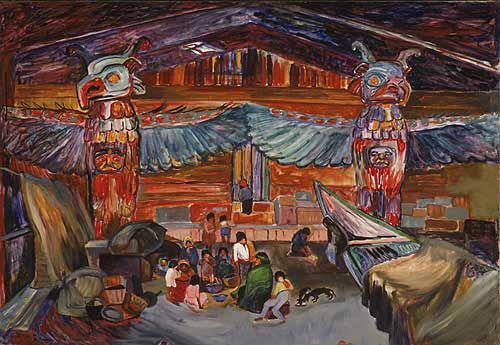
Here at YMCA Exchanges, we’re big fans of travel, especially when it comes to taking those kinds of trips that not only leave you with good memories for years to come, but those that leave you with ideas to improve your life right after you come back. Those kind of trips that make you want to tell everyone else *right now* about what you saw and how they have to see it too (in real life, not just through your Instagram page). Canadians have been taking these kinds of trips for a long, long time, and this month’s hero of history–painter, writer and all-around inspirational person Emily Carr– is no exception. Of all the travels she took in her life (and there were many!) three trips in particular shaped the course of her life and are the reason why she is a Hero of History to us today.

Emily Carr was born on December 13, 1871 to British-born parents in Victoria, British Columbia, the 5th of 6 children. While growing up, she took an interest in the nature around her, which led her to draw many pictures of the trees, animals and beautiful scenery that was never too far from where she lived, despite no one in her family having any aspirations to making art and a lack of artistic role models. Emily’s parents died when she was in her early teens, and she took comfort in her art. Some time later, she convinced her guardians to send her to the California School of Design in San Francisco, and while there, she built on her artistic talents, learning the basics of painting. She returned to British Columbia three years later and began using her newly minted skills, teaching art classes for young children.
While living in Victoria, she realized that the art world outside of her hometown was brimming with new styles, influences and potential, far more than the current level of her skills and what her hometown had to offer to improve those skills. She seized an opportunity to travel to France with her sister Alice in 1910, and arrived in Paris to discover the modernist art movement, among the many others that were starting at the time. Emily took classes at the famous (and controversial for its time, as it was the first to accept female students) Academie Colarossi, but ultimately developed her talents with a British artist, Harry Gibb. Despite the budding art movements of cubism, futurism, abstraction, and fauvism, Emily developed her own post-impressionist style of painting, and returned to Victoria in 1912 with a renewed and improved set of skills to use in her creations.
In addition to the nature around her, Emily had always taken an interest in the Native peoples of the Pacific Coast, who shared much of the same landscape, but were a world away in terms of their customs, lifestyle, and especially art. The goal for the next stage of her artistic creations was to document the various totem poles and other artistic parts of the lives of the First Nations of BC. To do this, she traveled to the Queen Charlotte Islands and the Skeena River area for 6 weeks, documenting the art of the Haida, Gitksan, and Tsimsham people. The drawings and carvings she made from this trip would be the basis of many of her most famous works which showcased two important themes: the life and art of the Aboriginal cultures of the past, and the landscape of west coast Canada.

Though much of her work was unknown to Canada until after her death in 1945, Klee Wyck (“the laughing one”, her name given to her by her Native friends while traveling through the Queen Charlotte Islands) made an impact on many works of Canadian art in the years afterwards, especially those depicting Native culture. She is known as a “Canadian Icon” of Canadian art. From her travels to the United States, France and within Canada, her life is a statement in that travel leads us to open our horizons, to tell our stories and more importantly, to share the stories of others.

One comment